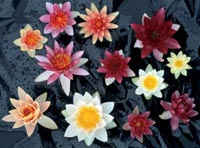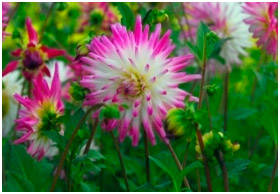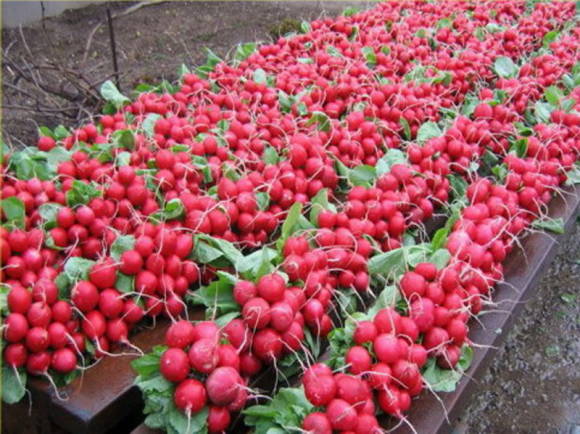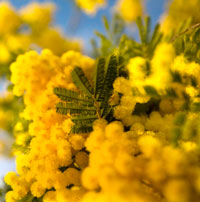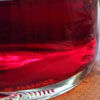In recent years, amateur gardeners have sharply increased their interest in such a rather uncommon culture as thorny plum, the fruits of which, however, are widely used for canning. Trees are thorny, if we compare them with plum varieties, they are much less capricious and more resistant to unfavorable climatic conditions, which contributes to their reliable and stable productivity, even in the harsh northern and equally harsh eastern regions of the non-chernozem zone. In addition, thorny plum begins to bear fruit much earlier (already in the 2nd year, and not in the fifth or even seventh, like a plum) and can give significant yields, often exceeding 30 kg of fruits per tree.

Nutritional and medicinal properties of the culture
The fruits of thorny plum contain up to 10% sugars, about 12% organic acids, as well as biologically active, pectin and mineral substances necessary for a full life of a person.
As for canning qualities, pectins, tannins, and dyes of polyphenolic nature, which have P-vitamin activity and give an astringent taste to fruits, play an important role here.
The fruits themselves and their processed products are often used for medicinal and prophylactic purposes, especially for improving and normal functioning of the stomach and intestines (especially with low acidity). The fruits of thorny plums and products of their processing are contraindicated for people suffering from heartburn or increased acidity of gastric juice.
Some biological features of culture
Ternoslum is a subspecies of domestic plum, which belongs to the genus Plum. (Prunus). From the name it is clear that not everything is so simple here - this is a natural hybrid of plum and blackthorn, but it turned out from the cross-pollination of these two crops in nature. Unlike the rather sweet homemade plum, the fruits of the thorny plum have a somewhat astringent taste, thorns can be observed on the shoots, and the plant itself is quite resistant to frost.
This culture is grown as an ordinary tree, reaching a height of 5 m, less often as a multi-stem bush with elliptical toothed leaf blades and snow-white flowers blooming in the last month of spring. Subsequently, fruits ripen, ovoid or oval, weighing up to 15 g, purple, and in full ripeness - bluish-dark in color. The taste of the fruits is tart, tart.
Ternosplum, in contrast to the more known plum, differs not only in increased winter hardiness, but also in drought resistance, withstands up to -37 ° C and bears fruit completely without watering. Loves fully lit places, moist, loamy and well-drained soils, rich in nutrients and without excess moisture. As for the acidity, the most optimal for it is neutral (pH 6.5-7). Grows poorly on excessively dry soils.
Varieties of thorny plums
Despite the fact that thorny plum has been cultivated for more than 2000 years, there are not so many varieties of it. Here are the most significant ones:

- Ternosliv Solyanovsky - a variety characterized by high winter hardiness and large-fruited. The taste of the fruit is very good, with hardly noticeable astringency. The variety has a high yield.
- Ternosliv Sadovy No. 2. The variety is selected in the Voronezh region and is one of the best in size and taste. Differs in high winter hardiness and productivity at the level of 25-30 kg per tree.
- Sloe Apricot... This is a hybrid obtained as a result of breeding work in which the Asian hybrid black apricot participated. Its fruits are purple, with slight pubescence, sour taste with apricot aroma, acquire a particularly pleasant taste after a couple of days of storage.
- Blackthorn 83. Another hybrid, this time with an American plum. This is no longer a tree, but a medium-sized bush, the fruits of which have an average ripening period. Ripe fruits are large, with a delicate aroma and are completely devoid of astringency.
- Fragrant thorns 16-9... It is a low-growing shrub with an early ripening period and a very pleasant taste and aroma. The yield is average.
- Ternoslum TSKHA... The variety is distinguished by fruits of violet-black color and abundant waxy bloom. The fruits are very sweet, with a dessert taste, with a well-separable stone. The yield and winter hardiness of the variety are very high.
 |  |
Reproduction of thorny plums
Thorny plum seeds are not propagated, if only for breeding purposes, therefore, the main emphasis is on vegetative methods, among which the most popular is propagation by root shoots, green, semi-lignified and lignified cuttings, budding and copulation.
Own-rooted seedlings are valued higher, reproduction by root shoots is considered the simplest and most reliable way of obtaining them. It is harvested in autumn or spring, choosing only the most productive and outwardly healthy plants, in the future they can be used as mother plants. When propagating in this way, root suckers are selected, located at some distance from the trunk, in such cases, the root system is usually much better developed, and you can separate them from the mother plant without fear of damaging it. When digging, shoots pay attention to the roots: if they are sufficiently developed, then the plant is quite ready for transplanting to a permanent place, if not, then the plant should be grown. To do this, the shoots are cut to a height of 20-25 cm and planted in nutrient soil, usually next fall the plant is ready for transplantation to a permanent place. The indisputable advantages of this method are its simplicity and low cost of the material obtained. The disadvantage is the scanty production of seedlings, that is, this method is suitable only for domestic purposes.
The method of obtaining seedlings by the method vaccinations it is more difficult to implement it, you need to first grow rootstocks, which are quite suitable for seedlings of winter-hardy varieties of plum, felt cherry is also considered a good stock, besides, this stock helps to reduce the growth of the scion by 35-40%.
To get a seed stock, simply sowing seeds into the soil is not enough; for good germination, they need stratification in the refrigerator, the duration of which is 4-5 months. You can, of course, sow seeds in the fall so that they undergo natural stratification in the soil, but their germination rate decreases by 25%.
Seedling care consists in weeding, loosening the soil, watering and feeding. In late September - early October, the seedlings are dug up and, after cutting the roots and shortening the aerial part to 16-20 cm, they are added dropwise for the winter. In the spring, the seedlings are planted, placing them so that the distance between them is at least 15-20 cm. Usually, with proper care, by July (the time for budding), the diameter of the root collar is equal to or close to 1.2 cm. next year, if the budding result is negative or the rootstocks are too thick.

Agrotechnics of thorny plums
The preferred time for planting thorny plums (like all stone fruit crops) is spring, usually the end of April, because during this period the soil is most suitable for planting - it is rich in moisture and is already sufficiently warmed up.
The planting scheme depends on the variety - the strength of its growth, the diameter of the crown, and can be either 5 x 3 or 3.5 x 4.5 and even 3 x 3 m. , the dimensions of which are 60-70 cm in width and 40-50 cm in depth, but can vary depending on the degree of development of the root system, that is, be more or less. It is advisable to add fertilizers to the planting hole, which will help the plant quickly "get used to" in a new place. Usually humus, superphosphate and sodium sulfate are added, and, of course, the upper fertile layer of the earth in equal proportions in a total amount equal to a bucket.After planting, the root collar of the seedling should be 2-3 cm above the soil level.
Watering... Of course, the planted plants need to be watered, but the main thing here is not to overdo it (no more than 2 buckets per plant), but mulch the soil around with a layer of humus 2 cm in order to save moisture and slow down the growth of weeds.
Care... As for care, in the first few years after planting, it comes down to weeding and watering, then, as the plants mature, fertilizers, both mineral and organic, need to be applied. It is imperative to ensure that the soil of the near-stem circles is constantly loose and free of weeds.
Top dressing... Mineral fertilizers are best applied as follows - in the spring nitroammofosk in the amount of a tablespoon under each tree, can be dissolved in water, at the end of flowering - a teaspoon of potassium sulfate and superphosphate (or a tablespoon of potassium sulfate in a bucket of water), after fruiting - by 250 g of wood ash.
Pruning... A few words should be said about formations... This process is often ignored by hobby gardeners, but it is also important. Plants are formed of thorny plums either according to a sparse-tiered system, or give the plant a bush-like shape. Subsequently, in order to preserve the shape given to the plants, they carry out sanitary and anti-aging pruning, and also remove excess shoots.
With the aging of the bushes, they are rejuvenated due to strong coppice shoots, and they do the same when plants are damaged by severe frosts.
Diseases and pests... Of the diseases, the most dangerous is the perforated spot, and of the pests, the ringed silkworm; fight them in the usual ways - with approved fungicides and insecticides.
Harvesting thorny plums

The fruits of thorny plums are usually collected in boxes with a capacity of no more than 10 kg, placing the fruits in 2 layers. Harvesting of fruits is carried out at a time depending on their further purpose - for example, for fresh fruit consumption or for processing they are harvested in the phase of technical ripeness, for transportation - at an earlier period, when the fruits are just beginning to be colored and become softer, such fruits store well even in a regular refrigerator.
Using the fruits of the thorny plum
The fruits of the thorny plum are consumed both fresh and various processed products are made from them. Most often, the fruits are used for wines, liqueurs, liqueurs, juices, compotes, preserves, as fillings in cakes, as well as for drying.
Photos provided by the author



